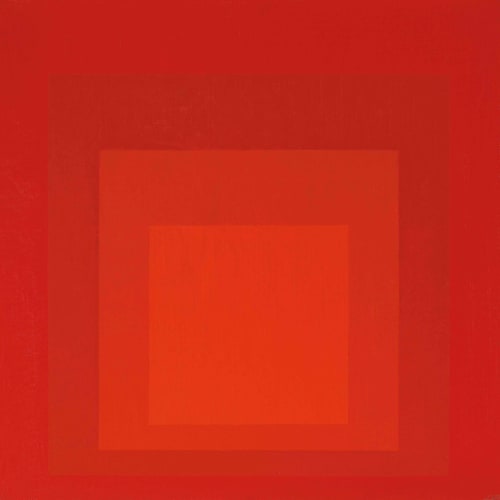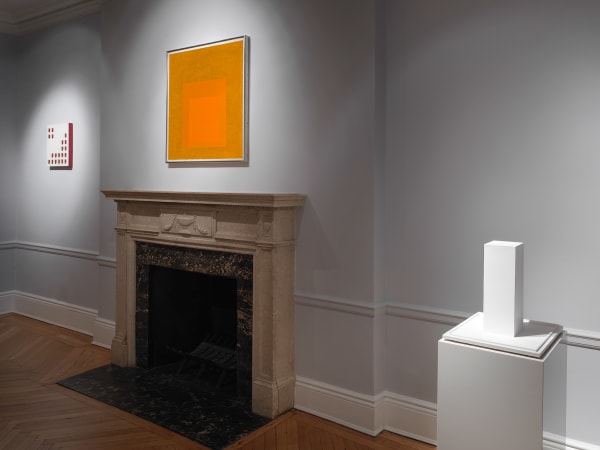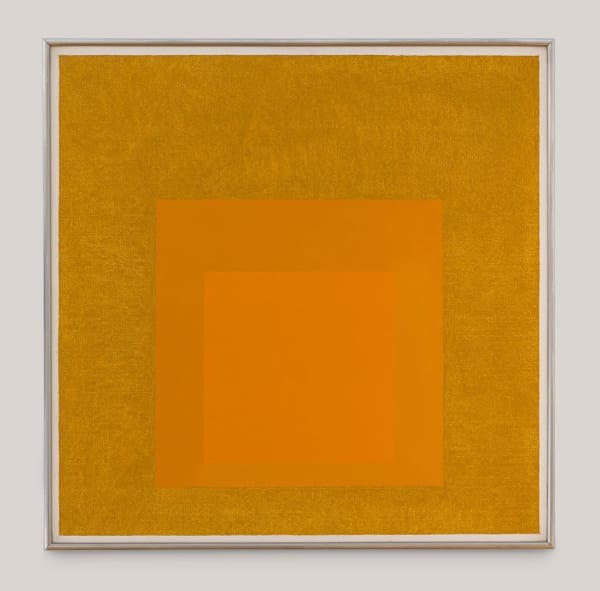“When you really understand that each color is changed by a changed environment, you eventually find that you have learned about life as well as about color.”
Josef Albers (Bottrop, Germany, 1888 – New Haven, CT, 1976) was a German-American artist known internationally for his geometric abstractions and the systematic study of color. Born in a family of craftsmen, Albers began studying painting in Munich, and in 1920 enrolled as a student at the Weimar Bauhaus. In 1925, Albers was appointed professor and taught design at the Bauhaus. Albers continued his teaching career after he immigrated to the United States in 1933. Together with Anni Albers, he founded the art department at Black Mountain College in North Carolina. From 1950 to 1958, Albers served as the chair of the newly created design department at Yale University in New Haven, CT. Some of his most prominent students during this era were Cy Twombly, Robert Rauschenberg, Richard Anuszkiewicz, and Eva Hesse. In 1949, Albers made his first linear Structural Constellation engravings and his first studies for Homage to the Square paintings. In 1963, Albers published a book titled Interaction of Color, which presented his extensive analysis of color theories and had a significant influence on art and art education. In 1971, he became the first living artist to have a retrospective exhibition at the Metropolitan Museum of Art in New York.
-

Summer Breeze
30 Jul - 22 Sep 2024This online viewing room features an exceptional selection of works by Henri Matisse, Ellsworth Kelly, David Hockney, Josef Albers, Sam Gilliam, and Alex Katz. From Matisse's lush trees of the...Read more -

Josef & Anni Albers
Something that Makes you Breathe with a Different Kind of Happiness 11 May - 23 Jul 2023Zeit Contemporary Art is honored to present an online viewing room with a curated selection of prints by Josef and Anni Albers. Widely known today for their bodies of work...Read more -

Minimal Means
Concrete Inventions in the US, Brazil and Spain 24 Jan - 16 Mar 2019Curated by Joan Robledo-Palop, Minimal Means is a conversation about space and the way people occupy and imagine that space in three parts of the world. The exhibit focuses on...Read more
-

Here Are the Pieces Collectors Will Be Fighting for at This Year’s Salon Art + Design
Cultured Magazine, November 5, 2024 -

Minimal Means: Concrete Inventions in the US, Brazil and Spain. Curated by Joan Robledo-Palop
JONATHAN GOODMAN, Arte Fuse, March 8, 2019 -

Nina Blumberg interviews Joan Robledo-Palop
Nina Blumberg, Cultbytes, February 19, 2019 -

Abstracciones sin fronteras
Descubrir el Arte, February 18, 2019 -

Artists Bianca Boragi and Julia Rooney to lead talk on Minimal Means exhibition
ArtFixDaily, February 13, 2019 -

Minimal Means: Concrete Inventions in the US, Brazil and Spain
José Juan Barba, Metalocus, February 8, 2019 -

Minimal Means
Meer, January 28, 2019 -

El minimalismo de EE.UU. se fusiona con España y Brasil en Nueva York
Helen Cook, El Obrero, January 25, 2019 -

Minimalismo de EUA, Brasil e Espanha se fundem em Nova York
Helen Cook, EFE, O Estadão, January 25, 2019 -

El minimalismo de EE.UU. se fusiona con España y Brasil en Nueva York
Helen Cook, La Vanguardia, January 24, 2019 -

Zeit Contemporary Art opens the exhibition 'Minimal Means: Concrete Inventions in the US, Brazil and Spain'
Artdaily, January 24, 2019 -

Minimalismo de EUA, Brasil e Espanha se fundem em Nova York
Helen Cook, UOL, Brazil, January 24, 2019 -

Obras del minimalismo por primera vez reunidas en Nueva York
El Universal, Mexico, January 24, 2019 -

El minimalismo internacional en Zeit
Ana Robledano, Ars Magazine, January 22, 2019 -

A Group Show at Zeit Contemporary Art Introduces a Dialogue on Minimal Means
Elena Martinique, Widewalls Magazine, January 22, 2019






















